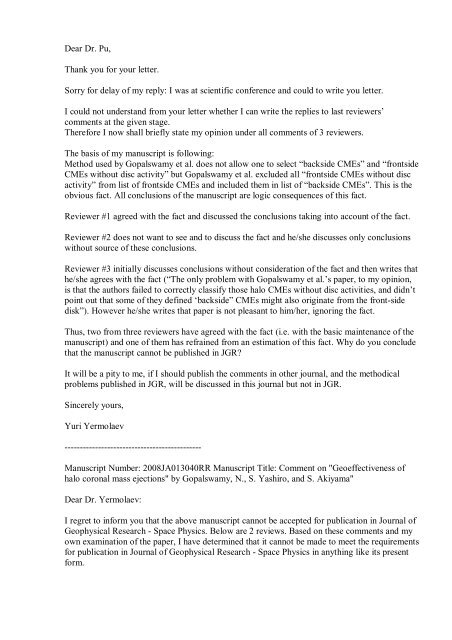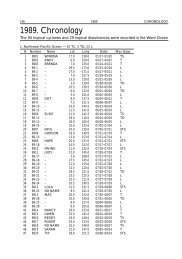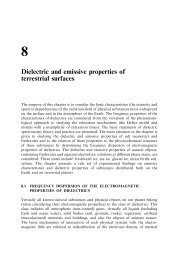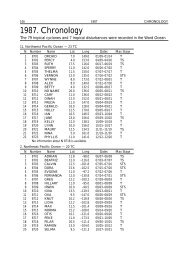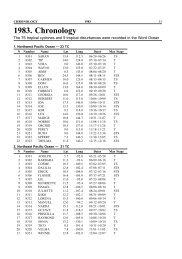Dear Dr. Pu, Thank you for your letter. Sorry for delay of my reply: I ...
Dear Dr. Pu, Thank you for your letter. Sorry for delay of my reply: I ...
Dear Dr. Pu, Thank you for your letter. Sorry for delay of my reply: I ...
Create successful ePaper yourself
Turn your PDF publications into a flip-book with our unique Google optimized e-Paper software.
<strong>Dear</strong> <strong>Dr</strong>. <strong>Pu</strong>,<br />
<strong>Thank</strong> <strong>you</strong> <strong>for</strong> <strong>you</strong>r <strong>letter</strong>.<br />
<strong>Sorry</strong> <strong>for</strong> <strong>delay</strong> <strong>of</strong> <strong>my</strong> <strong>reply</strong>: I was at scientific conference and could to write <strong>you</strong> <strong>letter</strong>.<br />
I could not understand from <strong>you</strong>r <strong>letter</strong> whether I can write the replies to last reviewers’<br />
comments at the given stage.<br />
There<strong>for</strong>e I now shall briefly state <strong>my</strong> opinion under all comments <strong>of</strong> 3 reviewers.<br />
The basis <strong>of</strong> <strong>my</strong> manuscript is following:<br />
Method used by Gopalswa<strong>my</strong> et al. does not allow one to select “backside CMEs” and “frontside<br />
CMEs without disc activity” but Gopalswa<strong>my</strong> et al. excluded all “frontside CMEs without disc<br />
activity” from list <strong>of</strong> frontside CMEs and included them in list <strong>of</strong> “backside CMEs”. This is the<br />
obvious fact. All conclusions <strong>of</strong> the manuscript are logic consequences <strong>of</strong> this fact.<br />
Reviewer #1 agreed with the fact and discussed the conclusions taking into account <strong>of</strong> the fact.<br />
Reviewer #2 does not want to see and to discuss the fact and he/she discusses only conclusions<br />
without source <strong>of</strong> these conclusions.<br />
Reviewer #3 initially discusses conclusions without consideration <strong>of</strong> the fact and then writes that<br />
he/she agrees with the fact (“The only problem with Gopalswa<strong>my</strong> et al.’s paper, to <strong>my</strong> opinion,<br />
is that the authors failed to correctly classify those halo CMEs without disc activities, and didn’t<br />
point out that some <strong>of</strong> they defined ‘backside” CMEs might also originate from the front-side<br />
disk”). However he/she writes that paper is not pleasant to him/her, ignoring the fact.<br />
Thus, two from three reviewers have agreed with the fact (i.e. with the basic maintenance <strong>of</strong> the<br />
manuscript) and one <strong>of</strong> them has refrained from an estimation <strong>of</strong> this fact. Why do <strong>you</strong> conclude<br />
that the manuscript cannot be published in JGR?<br />
It will be a pity to me, if I should publish the comments in other journal, and the methodical<br />
problems published in JGR, will be discussed in this journal but not in JGR.<br />
Sincerely <strong>you</strong>rs,<br />
Yuri Yermolaev<br />
---------------------------------------------<br />
Manuscript Number: 2008JA013040RR Manuscript Title: Comment on "Geoeffectiveness <strong>of</strong><br />
halo coronal mass ejections" by Gopalswa<strong>my</strong>, N., S. Yashiro, and S. Akiyama"<br />
<strong>Dear</strong> <strong>Dr</strong>. Yermolaev:<br />
I regret to in<strong>for</strong>m <strong>you</strong> that the above manuscript cannot be accepted <strong>for</strong> publication in Journal <strong>of</strong><br />
Geophysical Research - Space Physics. Below are 2 reviews. Based on these comments and <strong>my</strong><br />
own examination <strong>of</strong> the paper, I have determined that it cannot be made to meet the requirements<br />
<strong>for</strong> publication in Journal <strong>of</strong> Geophysical Research - Space Physics in anything like its present<br />
<strong>for</strong>m.
Sincerely,<br />
Zuyin <strong>Pu</strong><br />
Journal <strong>of</strong> Geophysical Research - Space Physics<br />
************************** Reviewer Comments **************************<br />
Reviewer #2 (Comments):<br />
Reviewer #2's third review report to "Yermolaev's second response to Reviewer #2's second<br />
review report"<br />
Different from author's first response, in his second response the author complains that "the<br />
purpose <strong>of</strong> <strong>my</strong> paper is to show the<br />
incorrectness <strong>of</strong> Gopalswa<strong>my</strong> et al.' method <strong>of</strong> data processing", and "the reviewer does not wish<br />
to discuss the essence <strong>of</strong> <strong>my</strong> manuscript and discusses the minor problems ...". The following is<br />
Reviewer #2's comments.<br />
1. What is the purpose and essence <strong>of</strong> the COMMENT paper? and<br />
Why Reviewer #2 discusses method and geoeffectiveness <strong>of</strong> other papers as well as the comment<br />
paper?<br />
Gopalswa<strong>my</strong> et al. [2007] obtained a significantly higher<br />
geoeffectiveness rates <strong>of</strong> frontside halo CMEs than previous studies (say, Kim et al. [2005]),<br />
and attributed the conflicting results to the different definition <strong>of</strong> 'halo' CMEs. The author <strong>of</strong> the<br />
comment paper attributed the high geoeffectiveness to the "incorrect" classification <strong>of</strong> the<br />
'frontside' and 'backside' halo CMEs, and concluded that the high geoeffectiveness obtained by<br />
Gopalswa<strong>my</strong> et al. was "incorrect".<br />
Obviously, the purpose or essence <strong>of</strong> the COMMENT paper is to<br />
"present our point <strong>of</strong> view on high geoeffectiveness <strong>of</strong> CMEs obtained in the paper by<br />
Gopalswa<strong>my</strong> et al" (see the first paragraph <strong>of</strong> the comment paper), i.e., to<br />
SHOW that Gopalswa<strong>my</strong> et al.' high geoeffectiveness rate is "incorrect".<br />
The "selection method <strong>of</strong> frontside halo CMEs" is only one <strong>of</strong><br />
arguments proposed in the debate.<br />
By discussing the selection method alone, as the author suggested, is obviously impossible <strong>for</strong><br />
Reviewers to decide<br />
which point <strong>of</strong> views about the cause <strong>of</strong> the high geoeffectiveness, the author's or Gopalswa<strong>my</strong><br />
et al', is acceptable, and to determine whether or not the high geoeffectiveness is incorrect.<br />
The scientific way to find out the answer is to examine<br />
and compare not only selection methods <strong>of</strong> "frontside"<br />
halo CMEs but also "different definitions <strong>of</strong> halo CMEs" used in<br />
Gopalwa<strong>my</strong> et al.' and Kim et al.' papers. It is also necessary to see the effects <strong>of</strong> the different<br />
definitions and the<br />
selection methods on the geoeffectiveness rate.<br />
That is just what Reviewer #2 did, and Reviewer #1 and Gopalswa<strong>my</strong> et al. did the similar way<br />
(see Reviewer #1's second report and Gopalswa<strong>my</strong> et al.' response). It is certainly necessary!
2. What is the CORRECT selection method (or observational definition) <strong>of</strong> the frontside halo<br />
CME?<br />
As shown in the first or second section <strong>of</strong> Gopalswa<strong>my</strong> et al.' and<br />
Kim et al.' papers, the observational definition <strong>of</strong> frontside halo CMEs used in the <strong>for</strong>mer is<br />
basically the same as in the latter, that is the halo CME that is associated with one <strong>of</strong> nearsurface<br />
activities, such as flare, filament disappearence, dimming, .... or moew briefly, the halo<br />
CME with near-surface<br />
activity. This is the standard definition <strong>of</strong> frontside CMEs used in liturature.<br />
It is true that there is no any specific kind <strong>of</strong> associated near-surface activities that has one-toone<br />
correspodence to halo CMEs. However, observations have shown that the percentage <strong>of</strong><br />
CMEs that are associated with flares alone is ~50%,<br />
and the percentage increases to ~75% when CMEs are associated with flares<br />
or filament disappearences [Munro et al., 1977]. It is expected that the percentage may be near<br />
100% as the number <strong>of</strong> associated near-surface activities used further increases. In fact, there<br />
have been studies that suggest that by using this standard definition, the detection rate <strong>for</strong><br />
backside and frontside halo CMEs is basically the same (see also Reviewer #1's second review<br />
report). This fact proves the correctness <strong>of</strong> the selection method used in Gopalswa<strong>my</strong> et al.'<br />
paper, and shows no "obvious logical mistake" at all.<br />
Based on the existence <strong>of</strong> the "problem storms", the author asserted that there were "frontside<br />
halo CMEs without disk (near-surface) activity", and this kind <strong>of</strong> "frontside halo CMEs without<br />
disk activity" "have been excluded from the frontside list and included in the backside list".<br />
What are the observational definitions the author used here <strong>for</strong> the "CME", the "halo CME" and<br />
the "frontside halo CMEs"?<br />
If the definitions are the same as what used in Kim et al.' paper, it is certainly a logic mistake to<br />
talk about "frontside halo CMEs without disk activity" because the frontside halo CME is<br />
defined as "the CME with disk activity".<br />
It is well known that "Problem storms" are observationally defined as the storms without any<br />
kind <strong>of</strong> solar activities associated, not only near-surface activities, but also CMEs. Why the<br />
author is so sure that "problem storms" must have CMEs associated with? If the "problem<br />
storms" were realy<br />
associated with CMEs, they would not be "problem" storms any more. It is another logic<br />
mistake.<br />
Reviewer #2 don't think the author could make such obvious logic mistakes. Perhaps, the author<br />
INCORRECTLY assumes that "problem CMEs" are defined as the storms with CMEs associated<br />
but without near-surface activity associated.<br />
The existence <strong>of</strong> "problem storms" means the existence <strong>of</strong> some kind <strong>of</strong> new CME that may be<br />
detected by new instrements in the future, but cannot be detected by presently-used instruments.<br />
It may also be expected that there are new near-surface activities that are associated with the new<br />
kind <strong>of</strong> CME because the CME is not an isolated phenomenon, it is one <strong>of</strong> manifestations <strong>of</strong> the<br />
reconfiguration <strong>of</strong> the solar atmosphere. There is htus no reason to rule out the possible existence<br />
<strong>of</strong> the new associated near-surface activities that can be used to distinguish frontside from<br />
backside CMEs.<br />
There<strong>for</strong>e, the selection method <strong>of</strong> frontside halo CMEs used in<br />
Gopalswa<strong>my</strong> et al.' paper is correct because no any observational evidence to support the<br />
coclussion made by the author.
3. Is the high geoeffectiveness "overestimated" or "incorrect"?<br />
As shown in Reviewer #2's first and second reports, it is the different definitions <strong>of</strong> "halo" CMEs<br />
used by Kim et al. and Gopalswa<strong>my</strong> et al. that make the significant difference <strong>of</strong><br />
geoeffectiveness. In Gopalswa<strong>my</strong> et al.' paper, "halo" CMEs are defined as the CMEs with<br />
apparent angular width <strong>of</strong> 360 degrees, i.e., FULL halo CMEs; and in Kim et al., "halo" CMEs<br />
are<br />
defined as the CMEs with apparent angular width greater than 120 degrees, i.e., "FULL +<br />
PARTIAL" halo CMEs.<br />
Because most <strong>of</strong> frontside PARTIAL halo CMEs could not encounter<br />
the Earth, it is understandable why Gopalswa<strong>my</strong> et al.' geoeffectiveness is significantly higher<br />
than Kim et al.'. Actually, using the data in Gopalswa<strong>my</strong> et al' paper, the low geoeffectiveness<br />
can also be obtained if using the same definition <strong>of</strong> halo CMEs as used by Kim et al., as shown<br />
in Reviewer #2's first report.<br />
In summary, both the selection method <strong>of</strong> frontside halo CMEs<br />
and the high geoeffectiveness in Gopalswa<strong>my</strong> et al.' paper is reasonable, and acceptable. The<br />
arguments and conclusions in the comment paper are incorrect.<br />
Reviewer #3 (Comments):<br />
The comment on Gopalswa<strong>my</strong> et al.'s higher rate <strong>of</strong> geoeffective<br />
front-side full-halo CMEs made by Yermolaev, to <strong>my</strong> opinion, is<br />
not valid. In Yermolaev's comment, he/she criticizes that<br />
Gopalswa<strong>my</strong> et al. use harder/illogical criteria to filter<br />
front-side CMEs, which leads those front-side CMEs without<br />
disk activities missed and there<strong>for</strong> yields false high rate.<br />
The critic doesn't realize that the high rate is due to the<br />
stricter selection <strong>of</strong> halo CMEs, not the stricter selection<br />
<strong>of</strong> front-side CMEs. In different studies, different<br />
definitions <strong>of</strong> halo CMEs are used. For example, halo CMEs<br />
actually mean those CMEs with angular with larger than 140,<br />
130, or 120 degrees in many studies, such as by Kim et al.<br />
(2005), Wang et al. (2002), Webb et al. (2000), and St. Cyr et al.<br />
(2000). Different definitions will cause different preselected<br />
sample. In Gopalswa<strong>my</strong> et al.'s paper, only FULL halo CMEs are<br />
considered, that results in 378 events (note this number is <strong>for</strong><br />
all halo CMEs no matter where did they come from) from 1996 to<br />
2005. We can make a comparison <strong>of</strong> this number with the number, 883,<br />
from Kim et al.'s paper. It's obvious that the number by<br />
Gopalswa<strong>my</strong> et al. is 42.8% <strong>of</strong> that by Kim et al. even though<br />
the statistical period in Gopalswa<strong>my</strong> et al.'s paper is more<br />
than two-year longer than that in Kim et al.'s paper. It's<br />
generally accepted that the wider the CME angular width is,<br />
the higher probable is the CME to encounter the Earth and cause<br />
geoeffectiveness. It is because a wider angular width means<br />
that either the location <strong>of</strong> a CME is closer to the center <strong>of</strong><br />
solar disk, where the CME right faces to the Earth, or the
actual angular size is larger. I notice that based on Kim et al.'s<br />
paper, the rate <strong>of</strong> geoeffective CMEs increases to > 80% if<br />
only the CMEs with location 400 km/s<br />
are considered. Thus, it could be expected that the rate should<br />
be higher as the selection threshold <strong>of</strong> halo CMEs increases.<br />
The stricter selection threshold <strong>of</strong> halo CMEs is already<br />
clearly claimed in the Introduction and Discussion <strong>of</strong><br />
Gopalswa<strong>my</strong> et al.'s paper. I don't think readers will be<br />
misled. This is <strong>my</strong> first reason why I said that Yermolaev's<br />
comment is invalid.<br />
Yermolaev criticizes that the front-side halo CME list by<br />
Gopalswa<strong>my</strong> et al. is not complete, because those<br />
non-disk-activity associated halo CMEs might also originate<br />
from the front side <strong>of</strong> the solar disk. However, I think<br />
the critic also has no clue which non-disk-activity associated<br />
halo CMEs do come from front-side disk. Excluding all<br />
undeterminable events from the final sample is a common<br />
treatment applied in almost all studies in this area. I am<br />
hard to understand why only the study by Gopalswa<strong>my</strong> et al.<br />
catches the critic's doubt. As to those 'problem events', I<br />
have to say that there is no definite explanation on those<br />
events. An unsolved phenomenon can not be used as evidence to<br />
judge that the front-side halo CME list must be incomplete.<br />
No one can confidently claim that those problem events are<br />
caused by the front-side CMEs without any disk activities.<br />
There is indeed another explanation with some indirect<br />
evidence that some backside CMEs can affect the Earth (Webb<br />
et al., JGR, 2000; Zhang et al., ApJ, 2003; Wang et al., Sol<br />
Phys, 2004). That's <strong>my</strong> second reason.<br />
Third, I would argue with Yermolaev that if the CME list is<br />
not complete, how large the percentage <strong>of</strong> the front-side CMEs<br />
should be. The present CME list suggests that about 61% halo<br />
CMEs come from front-side disk, which is reasonable in<br />
statistics (ideally the percentage is 50%). The only problem<br />
with the Gopalswa<strong>my</strong> et al.'s<br />
paper, to <strong>my</strong> opinion, is that the authors failed to correctly<br />
classify those halo CMEs without disk activities, and didn't<br />
point out that some <strong>of</strong> they defined "backside" CMEs might also<br />
originate from the front-side disk. But those unknown false<br />
backside CMEs should occupy a really small fraction, and will<br />
not significantly impact the results by Gopalswa<strong>my</strong> et al. The<br />
focus <strong>of</strong> Gopalswa<strong>my</strong> et al.'s paper is on those definite<br />
front-side full-halo CMEs. So I don't think that Gopalswa<strong>my</strong> et<br />
al. made a big mistake in their study. Overall, I think that the<br />
comment by Yermolaev is not worthy to be published.


